FairUTU
Ethics are one of the fundamental values of the University of Turku. Ethicality indicates striving for good and correct decisions.
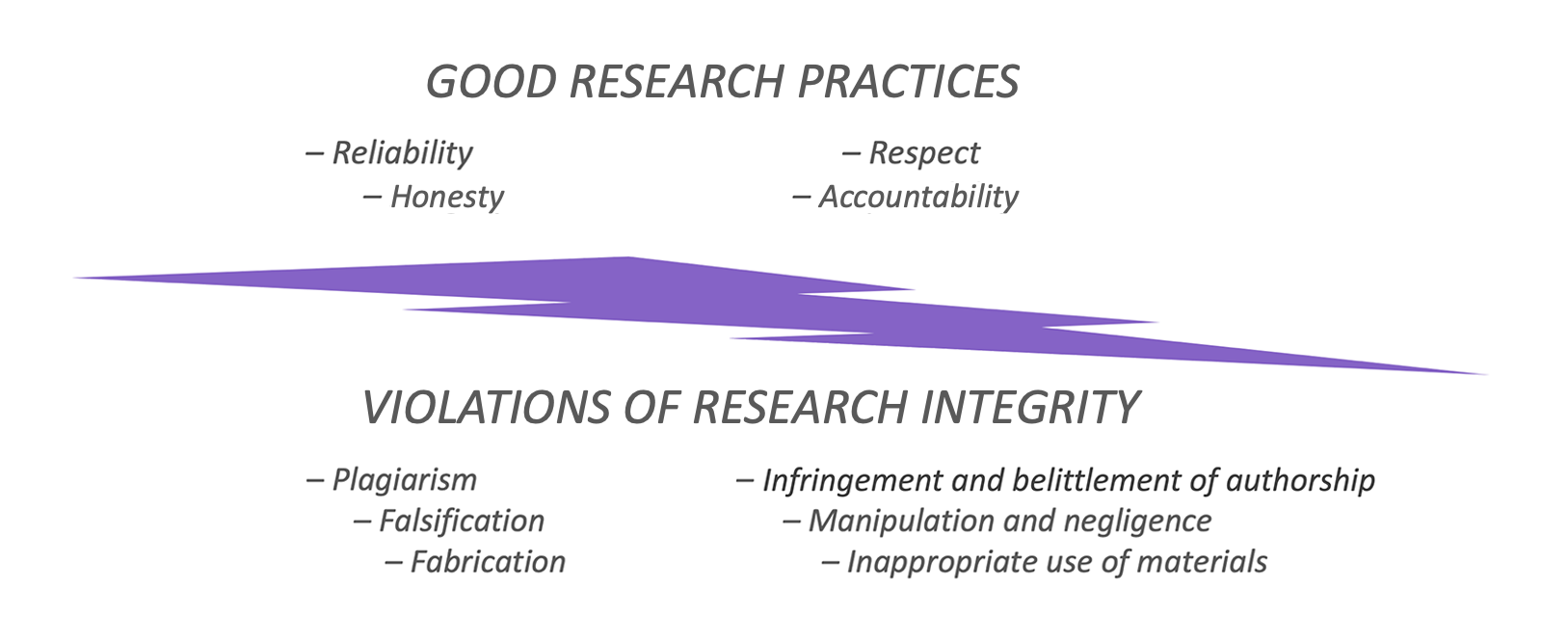
In collaboration with the Finnish research community, the Finnish National Board on Research Integrity, TENK, has published the The Finnish Code of Conduct for Research Integrity and Procedures for Handling Alleged Violations of Research Integrity in Finland 2023 (RI Guidelines). The aim is to promote responsible research practices and ensure that alleged violations are handled expertly, fairly, and with consistent criteria.
The RI Guidelines also provides the basis for the UTU's own ethical guidelines and academic misconduct handling process. Its principles support high-quality research and education, while violations of the RI weaken the scientific community's effectiveness and the quality of its results.
RI is based on international procedural guidelines, the purpose of which is to ensure the ethical acceptability of the research and the credibility of the results, as well as the effectiveness of the scientific community. Its basic requirements are reliability, integrity, respect and responsibility.
- Reliability involves careful planning and anticipation in research, ethical application of methods, analyses, and the use of financial resources.
- Honesty is achieved when scientific activity is consistent and monitored and reported openly, fairly and impartially, including recognising uncertainties.
- Respect involves respecting research results generated by predecessors and contemporaries and recognising the intellectual debt owed to them; and, like the research community and research subjects, the life circle of society, natural ecosystems and human cultural heritage that provides the prerequisites for scientific activity are also valued.
- Accountability is commitment to all stages and obligations of the scientific work process. They start from the planning of the research idea and its implementation, goal-oriented work, and extend to the publication of results and impact assessment, and also require training, mentoring, guidance, and academic and project management to be realised.
There is also joint responsibility for the final results: if one member of the working group is guilty of plagiarism, the whole group may jointly bear the consequences of this fraud (for example, when the research publication is withdrawn from publication).
RIG is primarily a set of guidelines that ensure the prerequisites of scientific work, but deviations from its principles also diminish the value of study achievements:
fraud and negligence in their various forms bring to the teacher's desk performances that are not produced by the student themselves, or they do not reflect the knowledge base of observations that they are claimed to describe.
![]()
"Actions that violate RI undermine the fundamental principles of good scientific practice and damage the quality, credibility, authorship, or collaboration of scientific activities.
A violation of RI is considered to be:
- Intentional, serious misconduct against RI, or
- Activity in which RI has been seriously neglected due to carelessness or indifference, even if it would have been possible to comply with it, or
- Serious neglect of RI due to ignorance, resulting from not having taken steps to obtain clarity on the matter, even though it would have been possible." (Guidelines for RCR, 2023, p. 15)
The main types of violations of Responsible Conduct of Research are 1) fraud in scientific activities and 2) disregard for the obligations of good scientific practice.
Fraud
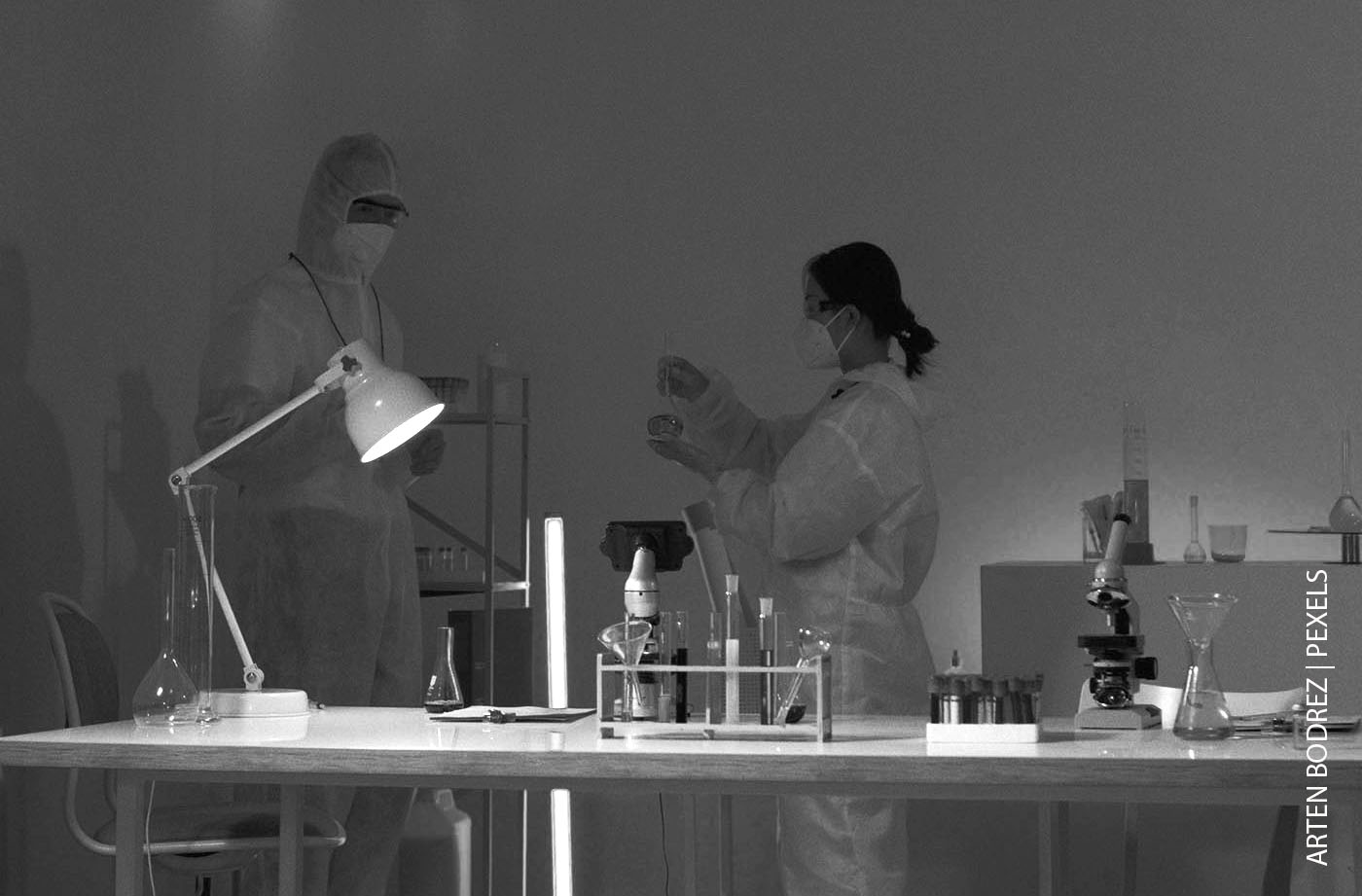 Fraud in scientific activities can involve plagiarism, distortion, or fabrication of research results.
Fraud in scientific activities can involve plagiarism, distortion, or fabrication of research results.
PLAGIARISM
- Plagiarism, or unauthorised borrowing, is the direct or modified presentation of another person's text or idea, research plan, manuscript, documented research results or data, text translation, or visual expression as one's own work. This also violates the original author's rights to control and use their own material.
Self-plagiarism is the direct re-use of one's own text or part of it in another academic work or article, if the existence of the original text is not mentioned in the new context.
Accuracy is required, in particular, in funded texts such as course reports (which earn credits) and articles (for which there is a merit and a possible writing fee).
Misappropriation is a parallel concept to plagiarism. Misappropriation occurs when someone presents other person’s findings without permission, for example, in a group work situation.
Easily recognisable and traceable forms of plagiarism include:
- Copying and pasting content from a source and adding one's own name as the author of such content;
- Masking plagiarism by copying another's text with minor changes. Methods of change may include altering the word and sentence order, replacing words with their synonyms, removing source references, or marking direct quotes as paraphrases by adding accompanying sentences;
- Self-plagiarism when using the same content in several different studies or publications in a way that misleads the examiner or publisher.
The less identifiable and verifiable forms of plagiarism are:
- Plagiarism of an idea, structure or content concept or style by following another author's reasoning step by step. For example, the content and thought structures of another thesis can be adapted as an accurate expression of their own results;
- Collaborative plagiarism, which refers to complete or partial free riding in group work;
- Institutional plagiarism, which means the use of assistants and ghostwriters in the preparation of self-presented texts.
FALSIFICATION
- Falsification can be related to research plans, funding applications, conference presentations and research publications, from which it is also transmitted to study and thesis processes.
- Falsification is the manipulation of work results or one's own merits by changing or selecting information so that some information is emphasised and other information is not mentioned.
FABRICATION
- Fabrication is the replacement of fact-based information with fiction.
- Often fabrication is the improvement of research results perceived as lacking with invented results.
- In extreme cases, the desired result has already been outlined, and an explanation and research arrangement that supports it are only being fabricated.
Disregard

Disregard for the responsible conduct of research represents deviations from the ethical code of science that do not fall within the three basic categories of fraud.
- Disrespecting authorship involves not describing the contributions of others or co-authors in a joint project when publishing results. Disregard for authorship according to the RCR guidelines is also demonstrated by presenting one's own previous results several times as apparently new.
- Serious negligence is forgetting the principle of care in the processing of research permits, preliminary evaluations, or data, as well as ignoring obligations regarding disability, access rights, storage, and data protection. As a result of these omissions, one can be guilty of improper use of materials.
- Manipulation involves distortion of research data and authorship information. Manipulation that violates RCR principles may also make it difficult and slow down the work of other researchers.
Severity of RI Violations
The severity of RI violations is assessed on a case-by-case basis, taking into account the practices and traditions of the research discipline in question. Since it is difficult to verify the intentions of activities, the evaluation is carried out from the perspective of the harm caused to the scientific community. Examples of factors that may be taken into account in the evaluation are shown in the diagram (RI Guidelines 2023, 16-17).
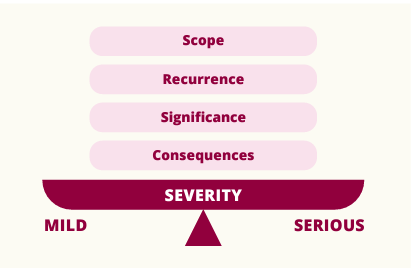
More specifically:
- Forms and concepts of academic misconduct are described in the Guidelines for Misconduct and Fraud at UTU.
- RCR violations
![]()
The ethical guidelines for learning give general answers to the questions on what ethical action is and what it is not.
The University requires that the members of our community make a personal commitment to these principles, which support the well-being of the work community and incentives to study, and protect against various forms of cheating. Regarding the correct use of source information and avoiding plagiarism, the student's ethical rule 3 and 4 are of central importance.
See: Ethical guidelines for learning
![]()
Ethical writing is based on three promises to the reader1:
- that the author is the sole originator of the text;
- that any ideas and texts borrowed from others are clearly identified as such by way of appropriate references, and;
- that the aim has been to include any indirect citations without distorting the factual content of the original.
The systematic use of a reference system requires the following:
- all direct and indirect quotes are indicated with references
- references are marked with the required annotation
- the bibliography is compiled in accordance with requirements
- all sources mentioned in references are included in the bibliography (or, depending on the reference system used, in footnotes)
- the text includes references to all sources mentioned in the bibliography.
Permissible citation2 requires that:
- all quotes are marked with the appropriate reference.
- the reference indicates the extent of the quote so that it is distinguishable from the author's own thinking/knowledge.
- in the case of a direct quote included without permission by the author of the source, the right to quote applies.
In accordance with the right to quote, a direct quote may be included in the text without the author's permission if all of the following conditions are met:
- the work used as source is published (made available to the public by permission of the author)
- the quote is made in accordance with good practice, which requires that (a) the quote is clearly separated from the personal rendering of the person making the quote, (b) the source is mentioned in the appropriate manner, and (c) the contents of the quote are acceptably connected to the personal rendering of the person making the quote
- the quote is only made to the extent required for the purpose.
Thesis texts created following these principles are transparently argued and the results are verifiable.
______________
1 Roig, M. 2006. Avoiding plagiarism, self-plagiarism, and other questionable writing practices. A guide to ethical writing.
2 Permission given by the original author does not as such suffice to meet the criteria of the concept “permissible citation” (cf. Silpiö 2012, 93.)
![]()
Common forms of plagiarism related to texts include:
- The source of a direct or indirect quote is not referenced.
- A direct quote is represented as an indirect quote.
- A superficially modified direct quote is marked as an indirect quote.
- A reference is given so that its scope in the text does not cover the quoted section in full.
- A reference is marked as referring to the primary source, even though a secondary source was used as the source of the quote in question.
The following examples represent some of the most common errors and defects in references that do not as such constitute forms of plagiarism:
- The reference covers the scope of the quote but it refers to an incorrect source or an incorrect point in the correct source.
- The details of the source given in the reference are not included in the bibliography.
- Information provided in the bibliography about the source is deficient or incorrect.
- The reference covers a section in the text that is larger than the quoted section.
- A direct quote does not meet the criteria of the right to quote.
- This is the most common form of misleading reference in Finnish theses, where a larger portion of the text is built on the basis of a source than is acknowledged. The part of the information that falls outside the area marked by the reference is plagiarism.
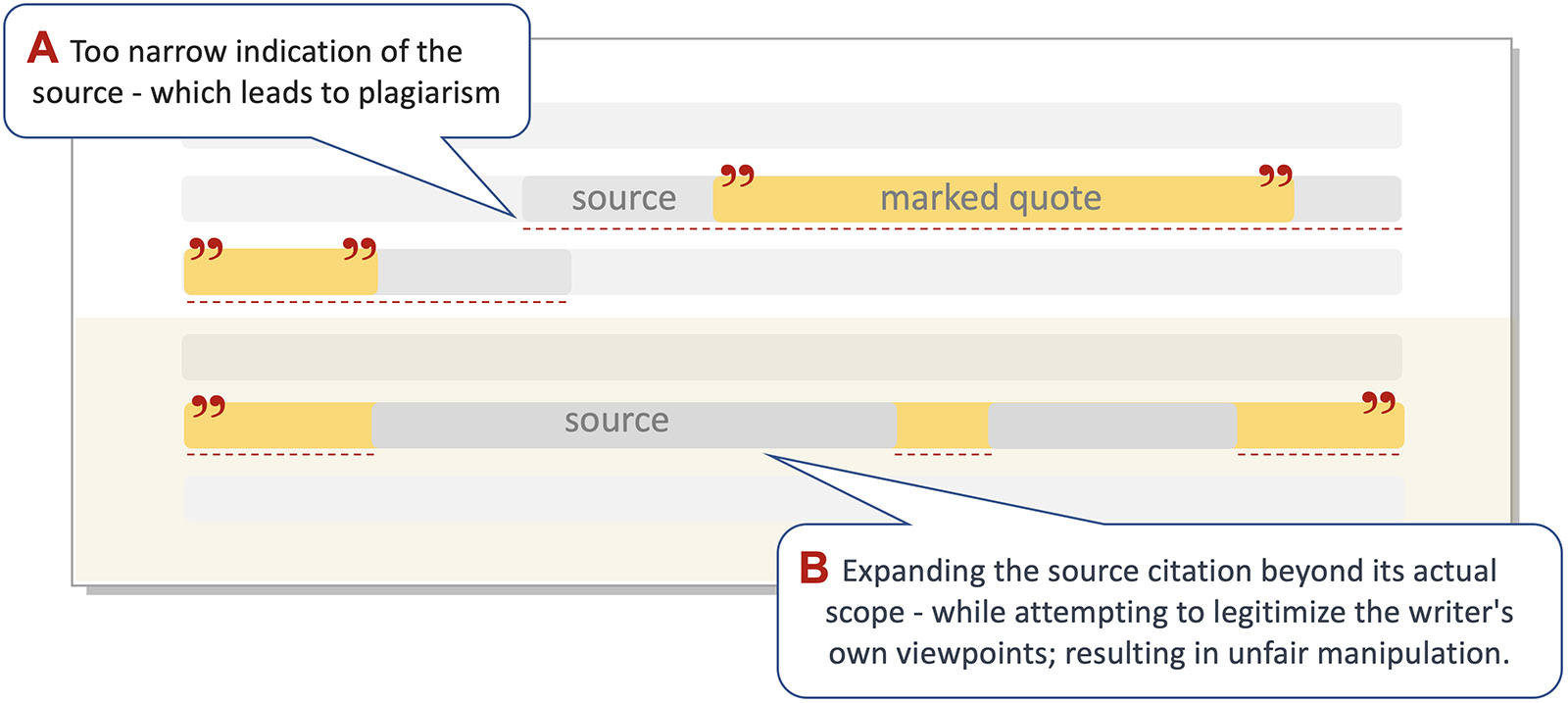
Working in a study or research group involves three typical forms of plagiarism:
- In case of peer plagiarism, a student presents another student's work as their own for the same or a corresponding assignment.
- In the case of dishonest cooperation (collusion), a student presents work completed in collaboration with another person as their own individual attainment.
- In addition, free-riding in teamwork results in a situation where a student presents work completed by another student as their own.

![]()
The guidelines describe types of ethical violations, as well as the process for handling violations and the resulting consequences.
When designing teaching practices to prevent academic misconduct and when handling suspected cases of academic misconduct, this document is a key guideline for all parties involved in the process.
The University of Turku has joint guidelines and faculty-specific support persons for suspected cases of misconduct and fraud.
In questions related to the use of the Turnitin system, the main users of Turnitin, Moodle, and UTUThesis provide instructions.
Research Integrity Advisors and the Development Specialist for research ethics offer support for the University staff in questions regarding research ethics.
In the faculties, the investigators (usually the Head of Academic and Student Affairs of the faculty) organise the necessary procedure and support the University’s staff and students in the process.
If you suspect that the checked text includes plagiarism, contact the author of the text first. Turnitin identifies intentional and unintentional mistakes. Based on the Universities Act, students have the right to be heard but they do not have a binding obligation to give a statement concerning suspected misconduct. There might be a natural and acceptable explanation for a suspicious find in the similarity report.
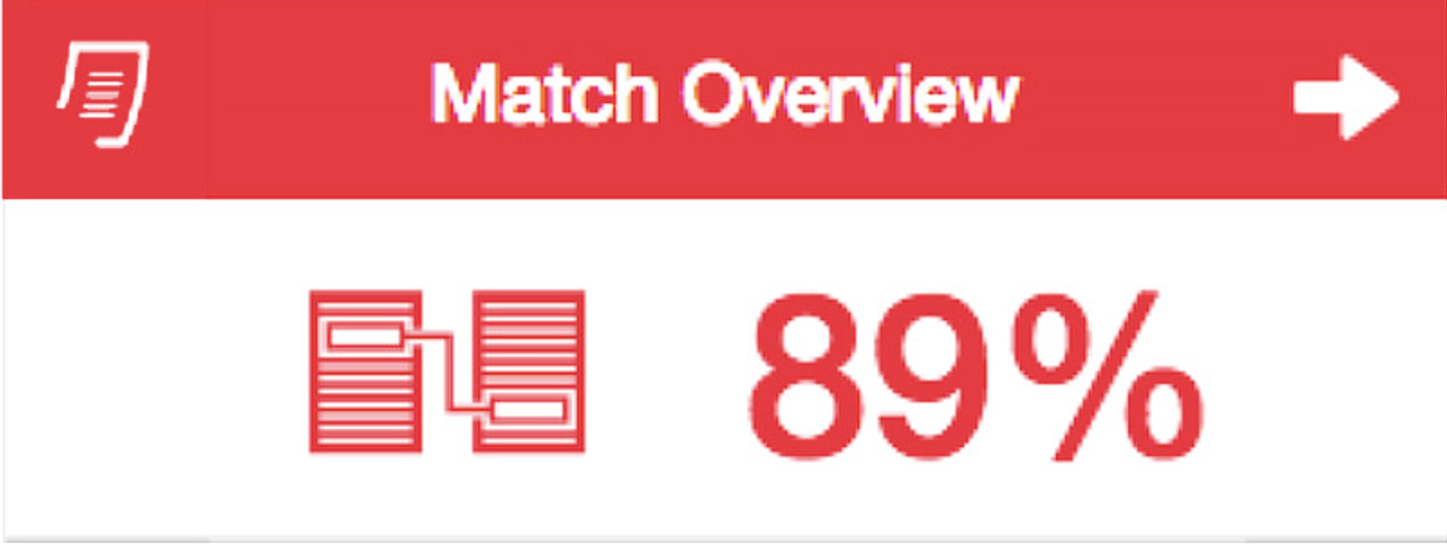
Similarity is not always plagiarism. For students, the differences in research reporting practices among various disciplines can create uncertainty. Each discipline has its own conventions in academic writing which are also reflected in the text’s similarity to other works in the similarity report. In describing the research, there is a larger variety of expressions available, for example, in human sciences than in natural sciences. The descriptive language of experimental research can be strongly standardised so that different studies are well comparable. This produces acceptable and even required similarity in researchers’ texts.
The context where the similarity takes place defines its significance in each separate case. Therefore, no reference values for an acceptable similarity percentage can be given for texts.
Evaluating whether the mistakes are intentional or not is crucial, but it can be challenging. Suspected misconduct challenges the trust between teachers and students. The investigation process can be mentally stressful for both parties. It is recommended that the initial investigation takes place face to face so that the problematic parts of the text can be discussed in more detail and avoiding misinterpretations.
Graph: Continuum of plagiarism related to study attainment.
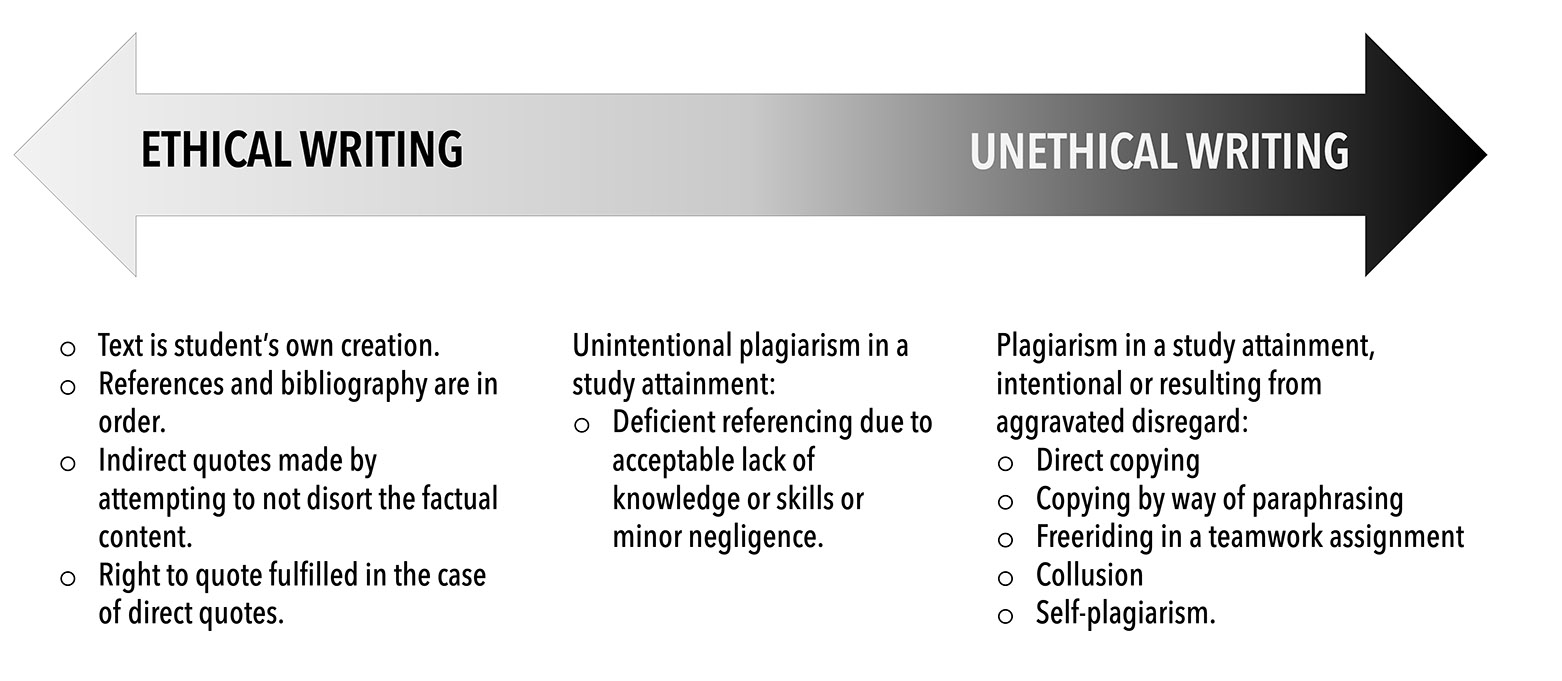
Texts containing ethically flawless, unintentional errors and representing conscious fraud. (See Roig 2006 and K. Silpiö 2012).
Evaluating whether the mistakes are intentional or not is crucial, but it can be challenging. Target-oriented and serious attempted fraud is investigated according to the joint guidelines for misconduct and fraud of all faculties of the University of Turku, committing to good governance. Recurring studying misconduct or fraud is interpreted as severe and can lead to e.g. temporary suspension. The frequency of fraud increases its severity according to the RCR guidelines.
Processing minor cases is guided by the principle that the suspect is first being guided in using sources correctly and they are asked to correct the noticed shortcomings and mistakes. Academic writing skills and requirements for good scientific practice are learnt throughout the studies. It is recognised that students can make mistakes without strict sanctioning.
Suspected plagiarism cases concerning theses are always investigated as serious attempted misconducts in studying. Using the form, the teacher/supervisor notifies their faculty’s investigator of the suspicion. Based on the similarity report and other necessary documents and after having heard the different parties, the investigator prepares an investigation memorandum to the faculty’s dean. If necessary, the processing of the matter proceeds from the dean to the Rector.
Support materials:
- Support for research ethics
- Notification of suspected fraud or fraud
- Report form for processed cases of academic fraud
- Guidelines for misconduct and fraud at UTU
- University’s Ethical Guidelines for Learning for teachers and students
- The Finnish Code of Conduct for Research Integrity and Procedures for Handling Alleged Violations of Research Integrity in Finland 2023

The University’s faculties report cases of misconduct in studying to a follow-up statistics annually. Once a year, the Rector of the University reports the investigated RCR violations in doctoral dissertations to the Finnish Advisory Board on Research Integrity.
If you are suspected of plagiarism, you always have the legal right to be heard based on the Universities Act.
Discussing the matter openly will help the teacher to give the necessary revision instructions for the text. There might be an acceptable reason for suspicious similarities that you may disclose to the teacher, or, in a process concerning a thesis, directly to the faculty’s investigator. Turnitin identifies intentional and unintentional mistakes.
Suspected misconduct challenges the trust between teachers and students. The investigation process can be mentally stressful for both parties.
Graph: Continuum of plagiarism related to study attainment.
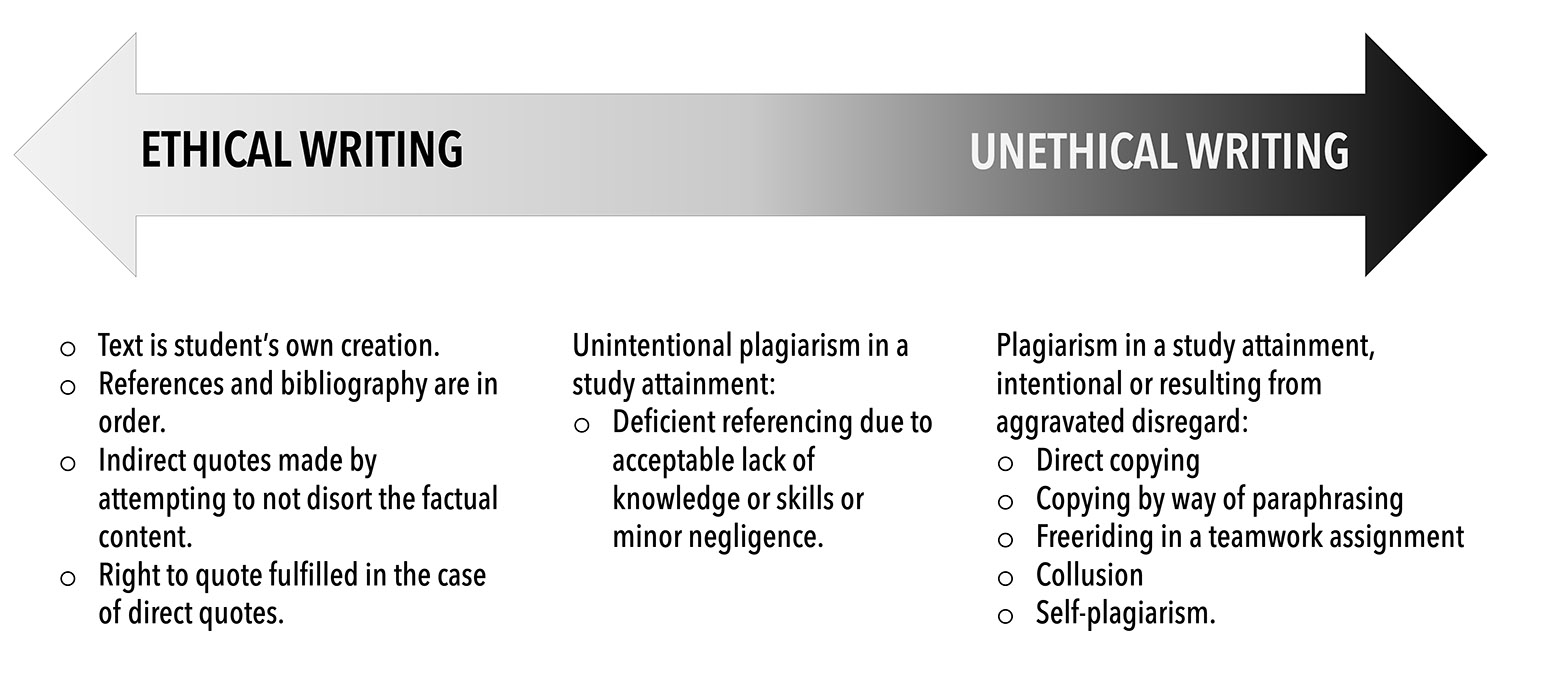
Texts containing ethically flawless, unintentional errors and representing conscious fraud. (See Roig 2006 and K. Silpiö 2012).
It is recommended that the investigation takes place face to face so that the problematic parts of the text can be discussed in more detail and misinterpretations can be avoided. If necessary, a support person can be asked to join the investigation session, e.g. the Student Union’s Academic Affairs Specialist (tyy-koposihteeri@utu.fi).
When finalising your thesis and suspecting plagiarism in an important source you have used, tell about the observation to your teacher for instructions on how to proceed in the matter. Even a problematic source may be used if source criticism is properly implemented.
- Guidelines for misconduct and fraud at the University of Turku
- University’s Ethical Guidelines for Learning for teachers and students
- The Finnish Code of Conduct for Research Integrity and Procedures for Handling Alleged Violations of Research Integrity in Finland 2023
![]()
In accordance with the Rector's decision Dno 918/002/2012, all degree-related theses at the University of Turku are checked for originality using the Turnitin plagiarism detection system. This requirement is also recorded in the University of Turku Regulation on Studies.
An inspection certificate or inspection mark is required for the thesis before it is accepted into the faculty's evaluation process. A note about the performed inspection is attached to the title page of the thesis.
Theses at different degree levels have different inspection processes:
- Theses related to Bachelor's degrees are checked using Turnitin so that they are not stored in the UTU database. The verification process follows the digital UTUKandi process, and a separate Control mark certificate is not used. The University Library is responsible for storing the theses, which are kept for 10 years.
- Theses related to Master's degrees are checked using Turnitin and stored in the Turnitin's UTU database. The verification process follows the digital UTUGradu process, and a separate Control mark certificate is not used. The University Library is responsible for storing the theses, which are kept permanently in the UTUPub archive.
- Theses related to postgraduate degrees are checked using Turnitin and stored in the Turnitin's UTU database. The verification mark is given on a certificate form or on an electronic form which is used to propose pre-examiners. The University Library is responsible for storing the theses. In addition, electronically published works are permanently stored in the UTUPub publication archive.
The Turnitin system is used through the Moodle learning platform. Moodle provides ready-made Moodle-Turnitin course templates for thesis checks. The sample templates have Turnitin assignments pre-set with the appropriate settings for each level of study.
Research plans related to Graduate School UTUGS and Doctoral Programmes are also checked using the Turnitin system.
See more: UTU Instructions for Turnitin
Turnitin Feedback Studio and Turnitin Integrity can be used as a submission channel for various types of credits, assignments, and exams. In addition to source analysis, Turnitin offers advanced evaluation & annotation tools for giving feedback.
The publications in the UTU Annales series are also recommended to be checked with the Turnitin system. Researchers have the possibility to use Turnitin to compare sources of corpus by means of self-defined procedures.
The greatest benefit of the comparative reports generated by Turnitin is when the system is used regularly during the writing process.
Recommendations for choosing Turnitin versions for different use:
- Exercises and home exams - Feedback Studio or Integrity
- Learning diaries - Feedback studio
- Course assignments, group assignments, group discussions - Integrity
- Translation tasks and calculation tasks - Feedback Studio
- Presentations and papers - Integrity or Feedback Studio
- Articles to be published - Feedback Studio
- Comparable and annotated materials - Feedback Studio
Instructions and recommendations for using Turnitin at the University of Turku
The use of Turnitin for originality checks in academic work is part of the university's quality system and is also recorded in the Study Regulations and guidelines for dealing with academic fraud.
![]()
Instructions for using Turnitin management and evaluation equipment can be found on the page UTU Instructions for Turnitin.

RI violations undermine the transparency and verifiability of research data.
Transparency requires correct information about the used sources, as well as the possibility to assess their quality and the way in which they are used.
Verifiability refers to the reproductibility of the research design and the verifiability of the results in accordance with the general criteria of the field of science.
The emergence of language model-based text generators in daily use by the scientific community has challenged the foundations of research ethics according to RI Guidelines.
- OpenAI's language model, which is currently the most widely used, anonymises the sources of information. The owners of the language model reserve (in some cases) licensing rights for the text content they have designed. The same issues regarding text usage rights also apply when using AI Text Classifier tools.
- There is no promise about the verifiability of the information - that the same request for information would produce the same answer when repeated - but the content changes dynamically.
- There is also no guarantee of information accuracy, with instructions to use separate fact-checking tools or traditional academic expertise and source comparison.
- The problem remains that the generated text does not refer to identifiable sources, the examination of which would enable an evaluation based on the internal conditions of the text.
- Paraphrases created with language technology also reduce the transparency of information and copyright protection for the original form of the text.
- OpenAI advises on the use of its language service:
Disclosing the use of ChatGPT
Educators should disclose the use of ChatGPT in generating learning materials, and ask students to do so when they incorporate the use of ChatGPT in assignments or activities.
Students can cite their ChatGPT use in Bibtex format as shown below:
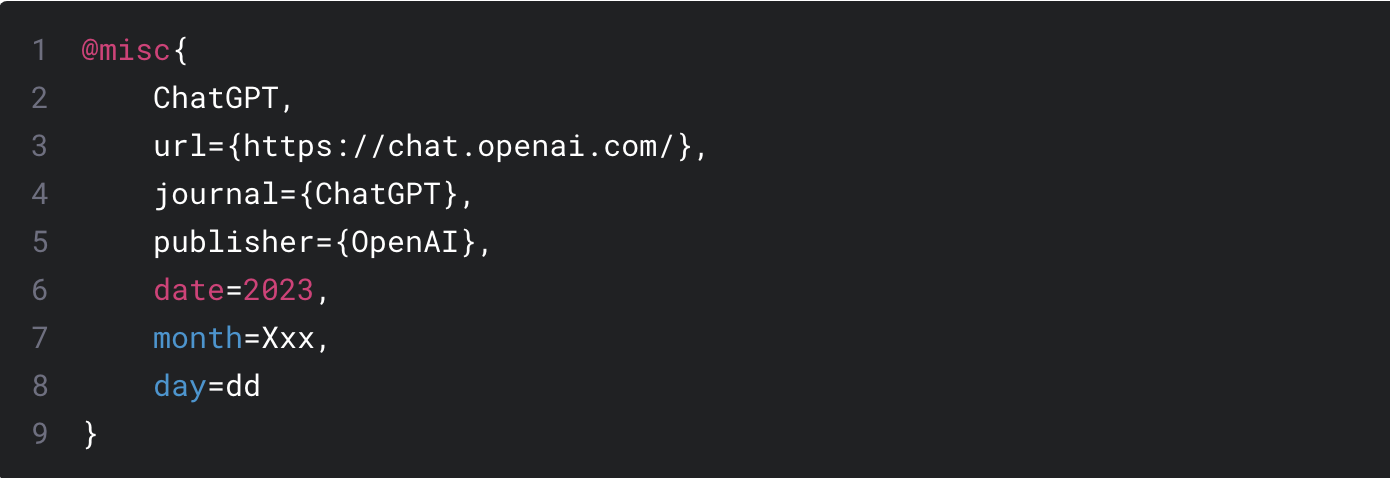
Guidelines for using artificial intelligence in teaching and training at the University of Turku.
Follow: Turnitin AI writing page